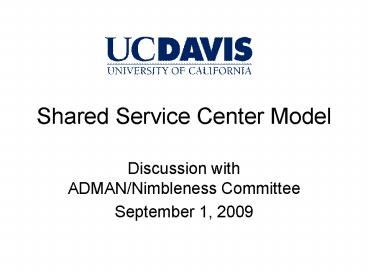Shared Service Center Model - PowerPoint PPT Presentation
1 / 9
Title:
Shared Service Center Model
Description:
Develop Hiring Plan and Recruit Shared Services Leaders. Refine Communications Plan ... Recruit Shared Services Personnel. Create Service Level Agreements ... – PowerPoint PPT presentation
Number of Views:2013
Avg rating:3.0/5.0
Title: Shared Service Center Model
1
Shared Service Center Model
- Discussion with ADMAN/Nimbleness Committee
- September 1, 2009
2
What Are Shared Services and What Are the
Benefits?
Shared Services is a customer-focused
organizational structure and service model that
provides back-office support primarily to
internal customers and eliminates redundant
processes, systems, and organizations.
- Standardization of processes and systems
- Increased levels of automation
- Reduction or containment of costs
- Improved controls
- Enhanced service levels
- Access to new technologies
- Optimization of skills/capabilities
Shared Services Enables
- Built upon standard processes, policies, and
systems - Focuses on delivering excellent customer service
- Strives for continuous improvement
- Run as a separate organization
- Enabled by emerging technologies
Key Shared Services Attributes
Adopted from Oracle Presentation Shared Services
in Higher Ed
3
Shared Services Model in Higher Education
- Shared services model combines the administrative
and business support functions of schools,
colleges and divisions. The services may include
a wide range of technical and functional business
processes agreed upon for inclusion by campus
stakeholders who mutually benefit by realizing
cost savings, improved access to technologies,
and enhanced levels of service. - The shared services model allows institutions to
focus more of their resources on their core
competencies of teaching, research and service
rather than business and technology services that
are critical, but serve rather than drive their
missions.
Adopted from Oracle Presentation Shared Services
in Higher Ed
4
The Case for SSC
- Focus on processes and leverage technology
- Productivity increases
- Responsible, accountable, accessible
- Dramatic re-engineering of processes
- Business professionals focus on strategic
initiatives - University-wide focus on education and research
5
Ideal processes for Shared Services have low
strategic impact and significant economies of
scale
- Payroll Processing
- Compensation
- Records
- Hire to Retire
- Benefits Administration
- Training Education
- Travel Expense
- Self Service
Human Resources
- General Ledger
- Accounts Payable
- TE Processing
- Accounts Receivable
- Planning Budgeting
- Purchasing
- Cash Management
- Internal Audit
Finance
- Standards
- Technology/ Development
- Desktop Support
- Applications Development
- Data Center Operations
- Application Maintenance
- Telecommunications
- Hardware Software Acquisition
Information Services
Logistics/ Materials Management
- Strategic Sourcing
- Asset Management
- Warehousing
- Inventory Management
- Transportation
- Call Centers
- Non-Emergency Service Calls
- Credit Collections
- Order Management
Customer Service
Legal Affairs
6
Shared Services vs. Centralized Services
SHARED SERVICES
DECENTRALIZEDD
CENTRALIZED
Customer Focused Services Independent
Entity Flat Structure Leading Practices Cost
Process Leadership
Negativess
Negatives
Redundant Inefficient Non-Standardized
Unresponsive Detached from Business Inflexible
Redundant Inefficient Non-Standardized
Economies of Scale Standardized Processes
Customer Focused Business Intelligence
7
Shared Services is often confused with the
centralization of functions into one physical
location. In fact, Shared Services is much more
Shared Services Objective
- Strategic pursuit of process standardization
enabling more efficient processing - Customer-service oriented mindset
- Back-office functions run as a front-office (run
like a business) - Service managed via Service Level Agreements,
contracts between operating units and the
Shared Services organization - Skilled and scarce resources leveraged across
multiple operating units - Operating units focusing on their core processes
and analysis
Scale Efficiency
Service/Responsiveness
8
Split of Savings
Only by addressing all three components
standardization, consolidation and
re-engineering, full benefits of implementing
Shared Services can be achieved
Examples
Components
Standardization
- Investment in leading-edge IT capabilities
- Implement global SAP standard
- Automation of core processes
- Standardize processes and policies
- Minimize number of different systems
25
Consolidation
- Single vendor master data base
- Central shared service center
- Moving to a low cost site
- Reduced finance staff and management layers
- Reduce physical locations
- Streamline organization
- Outsourcing, where applicable
50
- Process oriented organization
- Service culture through service level agreements
- Independent legal entity
Re-engineering
- Establish a service culture
- Organize around end-to-end processes
- Implement best practice processes
25
- Establish a service culture
- Organize around end-to-end processes
- Implement best practice processes
If a company simply consolidates to get the
economies of scale, 50 of the savings are left
of the table.
- Hackett Research 2004
9
Typically Shared Services Projects have 4 Phases
Typical Shared Services Road Map
3-5 Months
6-12 Months
2-16 months
10-14 Weeks
Assess
Design
Build
Deploy
- Design the Business Processes
- Design the Organization
- Design the Enabling Technology
- Select Location and Real Estate
- Develop Hiring Plan and Recruit Shared Services
Leaders - Refine Communications Plan
- Create Workforce Transition Plan
- Develop Training Plan and Management Development
Program - Design Facilities
- Design Service Management Approach Details
- Develop Service Management Processes
- Build Performance Support and Training Materials
- Build-out Facility
- Recruit Shared Services Personnel
- Create Service Level Agreements
- Develop Key Performance Indicators
- Develop / Deliver Build Communications
- Build the Organization
- Conduct Deployment Planning
- Execute Deployment Plan
- Confirm Service Level Agreements
- Conduct Training and Work Shadowing
- Develop / Deliver Deployment Communications
- Test Shared Service Center Readiness
- Execute Workforce Transition Plan
- Shared Services Vision
- Scope of Shared Services
- Current State Analysis
- Benchmarking/ Opportunity Assessment (done)
- High Level Operating Model
- Process Split Definition
- Change Management Strategy
- Business Case
- Implementation Roadmap
Current Project Focus
Pilot
Group 2
Group 3
Program-, migration- and change management
(ongoing)
Management Checkpoint
NOTE Timeframes above are illustrative and vary
depending on organization size, Shared Services
scope, ERP solution status, etc.































